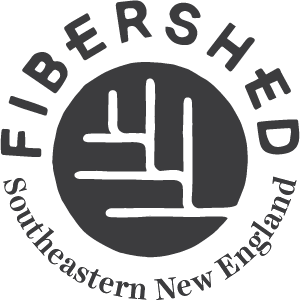Story and images by Fibershed intern Charlotte Atkinson
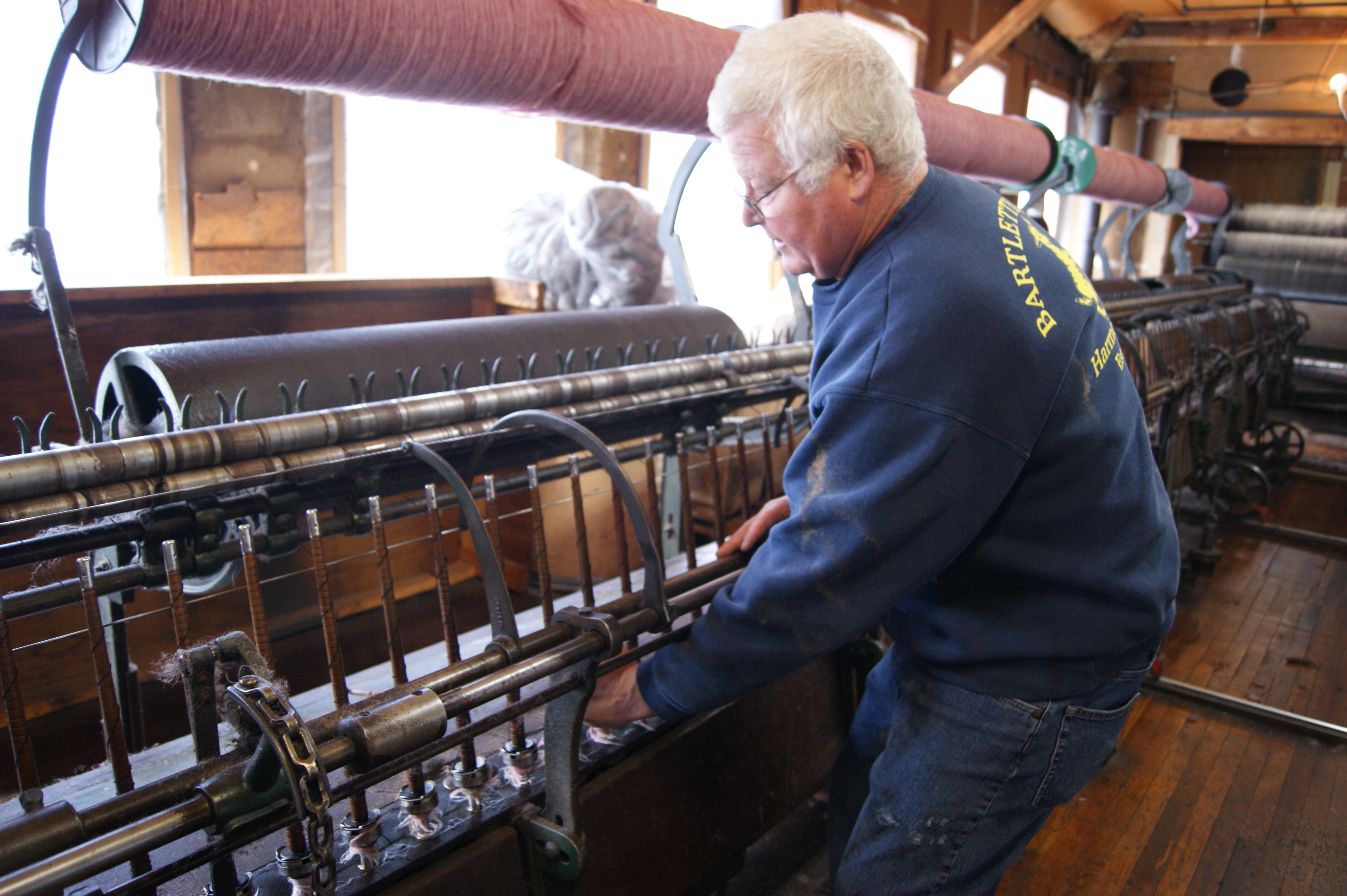
Lindsey Rice, Co-Founder of Bartlettyarns
Times have undoubtedly changed since the age of the Industrial Revolution in America. The textile manufacturing that this country was once known for has dwindled to a very near death as cheap labor in developing countries has made it almost impossible for American manufacturers to compete in the market. Despite this, a flicker of light continues to shine bright as a resurgence is well underway with torches held by the manufactures who refuse to let the flame blow out.
Case in point? Bartlett Yarns tucked away in the remote town of Harmony, Maine, a big piece of our current Southeastern New England Fibershed supply chain and current processor for our wool pool. Bartlett Yarns was established in 1821, and originally ran on water power like many other mills of its time. The mill provided local sheep farmers the invaluable service of spinning their wool into yarn, and remarkably still to this day, not a lot has changed. The company continues its tradition of working directly with local farmers within New England, providing custom processing services.
What makes the mill even more unique is the fact that it’s the last remaining and fully operating mule spun woolen mill in the United States. In its heyday, the mule was state of the art technology, as it had the capacity to spin 240 bobbins simultaneously. This technology completely revolutionized the way that yarn was spun, as it freed up time to do other chores around the house. Before the invention of the mule, homesteaders made their clothing by the practiced craft of handspinning on a spinning wheel.
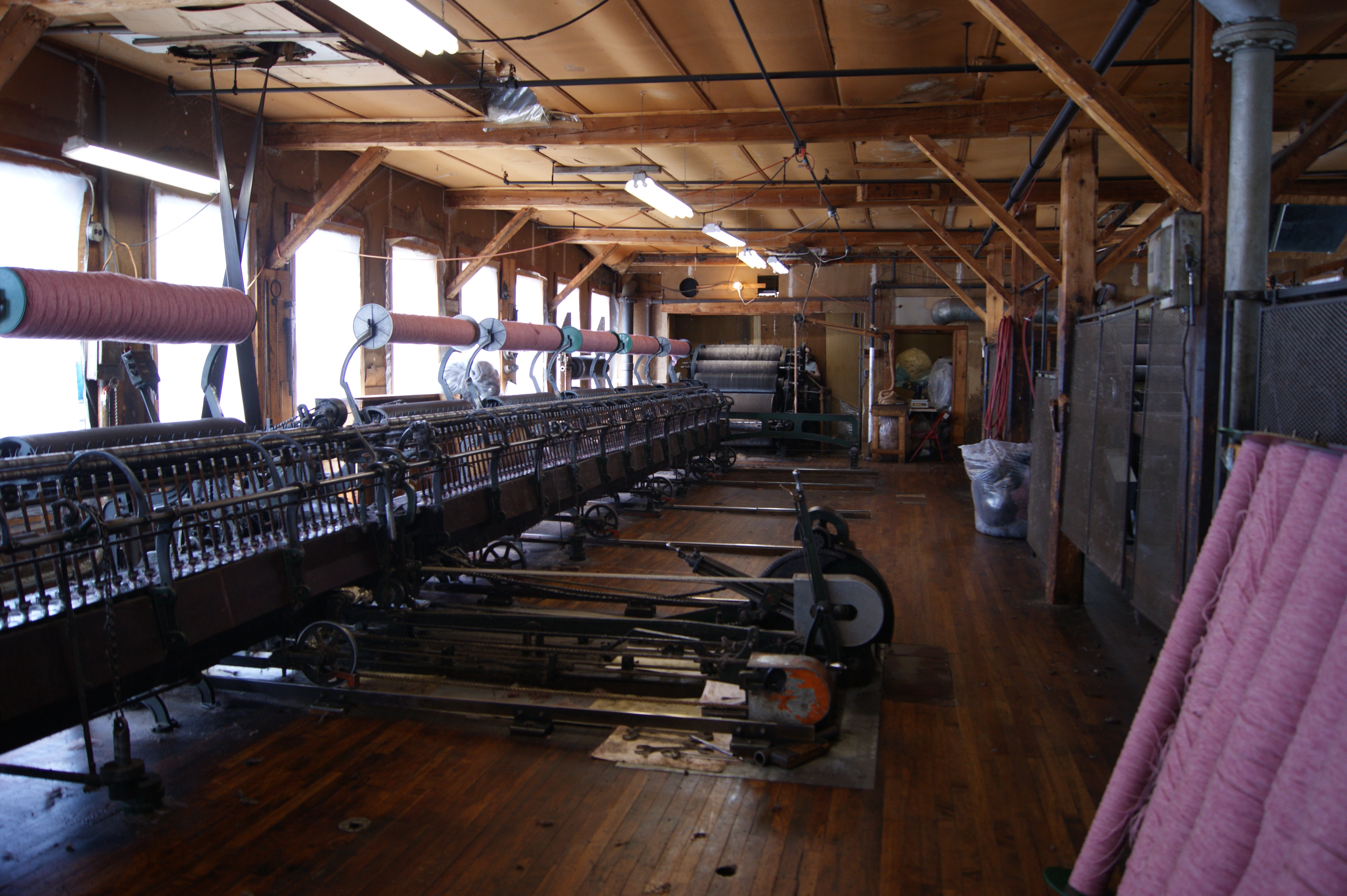
In 1920, a fire destroyed the original Bartlett Yarns building, and in 1921 the current building with metal clad fire-proof siding was rebuilt. The mill was established by Ozias Bartlett in 1821, and eventually his great grandson Harry inherited the business at age 16. In 1947, the mill was sold outside of the family, and in 2007 the current owners Lindsey and Susan Rice bought the mill. Today Lindsey and Susan are keeping the tradition alive and well.
“We have stayed smaller in that we didn’t get very large and do large industrial applications,” says Lindsey.
“We focused on providing yarn for the hand knitting trade. The heyday for Bartlettyarns was probably the 1920s and 1930s…keep in mind that people were still making a lot of their projects at home especially during the depression, you just couldn’t afford to go out and buy a set of clothes but you could get the yarn and make your own mittens, your own hat, or your own wool outerwear, sweaters and that kind of stuff. We’re still in that same niche in that 90% of what we produce is for the hand knitting trade.”
Currently Bartlett processes around 100 lbs of wool per day, and employs around 10 people. They do custom processing for farmers, and sell their yarns directly to knitters as well as wholesale to retailers and designers. For their own line of yarns, Lindsey sends 20,000 lbs of wool down to South Carolina to be scoured (washed) since there aren’t any large-scale scouring facilities left in New England.
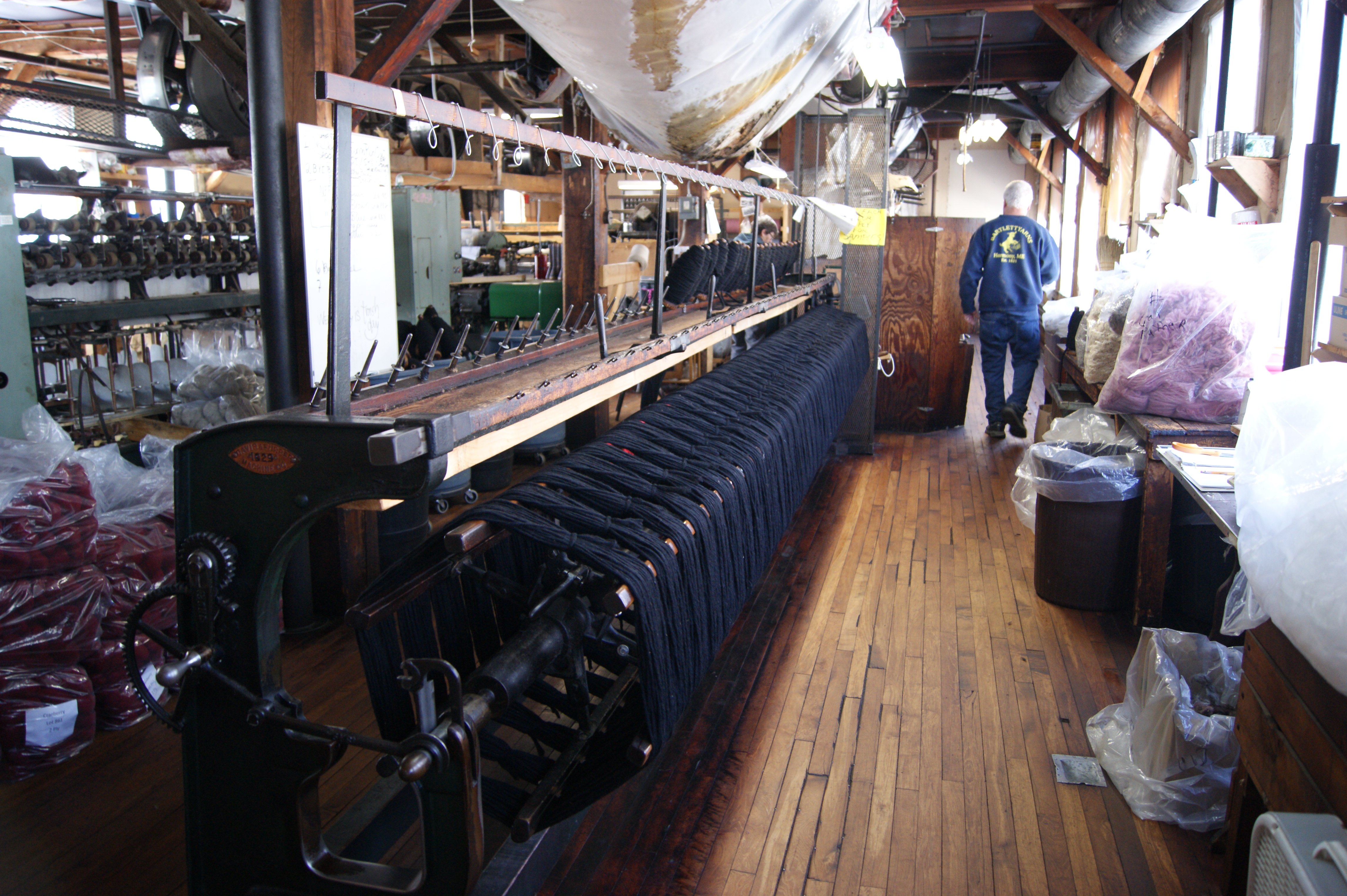
The washed fiber is then sent to Philadelphia to be dyed, and sent back to Bartlett to be spun. The first step of this process is for the wool to be sent through the duster, which removes any bits of hay and debris. Next the fiber is blended with different colors, opened and fluffed up as it moves through the picker. It is then ready for the carding machine which combs the fibers together, and is then drafted into thin pencil roving.
At this stage the mule is ready to work its magic. As a metal mechanism slides out on rivets in the wooden floor, 240 spindles of roving are drafted out and twist is put into the yarn. The mechanism then slides back in and the yarn is wound back onto the bobbins. The mule resembles the motion of a traditional hand spinner, and the result is a yarn with much more air and loftiness to it, a characteristic that you simply do not get from a commercially spun yarn. After this, the single is ready to be plied with another single on a different machine, and wound into skeins to be sold. Bartlett is a woolen spun mill which means that the fibers are tangled up as opposed to a worsted spun yarn in which the fibers are combed and aligned together to create a smoother yarn.
“Susan and I were involved with Bartlett Yarns for quite a number of years prior to us owning it, probably about 30 years we were customers. I used to do a lot of sheep shearing as a part of my income and a lot of people would just give you the fleece they didn’t know what to do with it, we also had a flock of sheep from our own farm, so we would bring the wool up here and trade it for finished yarn, and then my wife would make finished knit goods as well as sell the yarns at several farmers markets down in southern New Hampshire. I was up here one time dropping off some fiber, and I was talking to the owner and made a comment in passing that if he ever decided to retire we would like to step up and take over the challenge. He said that as a matter of fact he was thinking about it and we did some negotiating and came up with a price that both of us could live with,” says Lindsey.
The rest is history and a thriving current story still being written.
We asked Lindsey a few more questions after the writing of this story and he had some interesting things to say. Keep reading to learn more and watch this great video about Bartlett Yarns made by Maine Public Production.
What do you feel is so special about continuing the legacy of wool manufacturing in the modern age?
Well we enjoy manufacturing a good product, our employees are proud of what they manufacture and what they make, we’re utilizing an agricultural product that can be taken and turned into something of value and then given back to a customer. So we provide a wide range of products and some of those are as simple as just a skein of yarn and in some cases were we work with other mills in the area that do either weaving or knitting we’re able to provide a finished knitwear product or a woven product like a blanket. The sheep are out there right now making more wool, and you know I just think it’s a horrible waste to have people just throwing it in the compost pile when it’s a good usable product, it should be given some value added to it.
What are the realities of the wool industry within New England? What do you hope to see happen within the next 10 years or so?
Right now we are starting to see a real resurgence of people being a little more conscious of where their fiber is coming from, and there has been a large resurgence of people that are really looking for that Made in America label, right down to where the fiber is made in America not just the fact that it might be a mill that brought in Australian wool and did all the manufacturing to get to a finished product. They really want to see the entire thing made in the USA. Right now there is quite a bit of rising prices on wool for a farmer, especially the finer wools like Merino and Rambouillet… because more people are looking for those finer garments. New England tends to be more towards medium and longwools, it’s a different niche market. The yarns that we are generally making is not that super fine soft merino underwear. It’s not a super fine soft wool suit, but it is a good strong pair of wool mittens, a hat or a sweater. And it’s going to keep you warm and that’s what we specialize in and that’s what New England wools are really noted for.
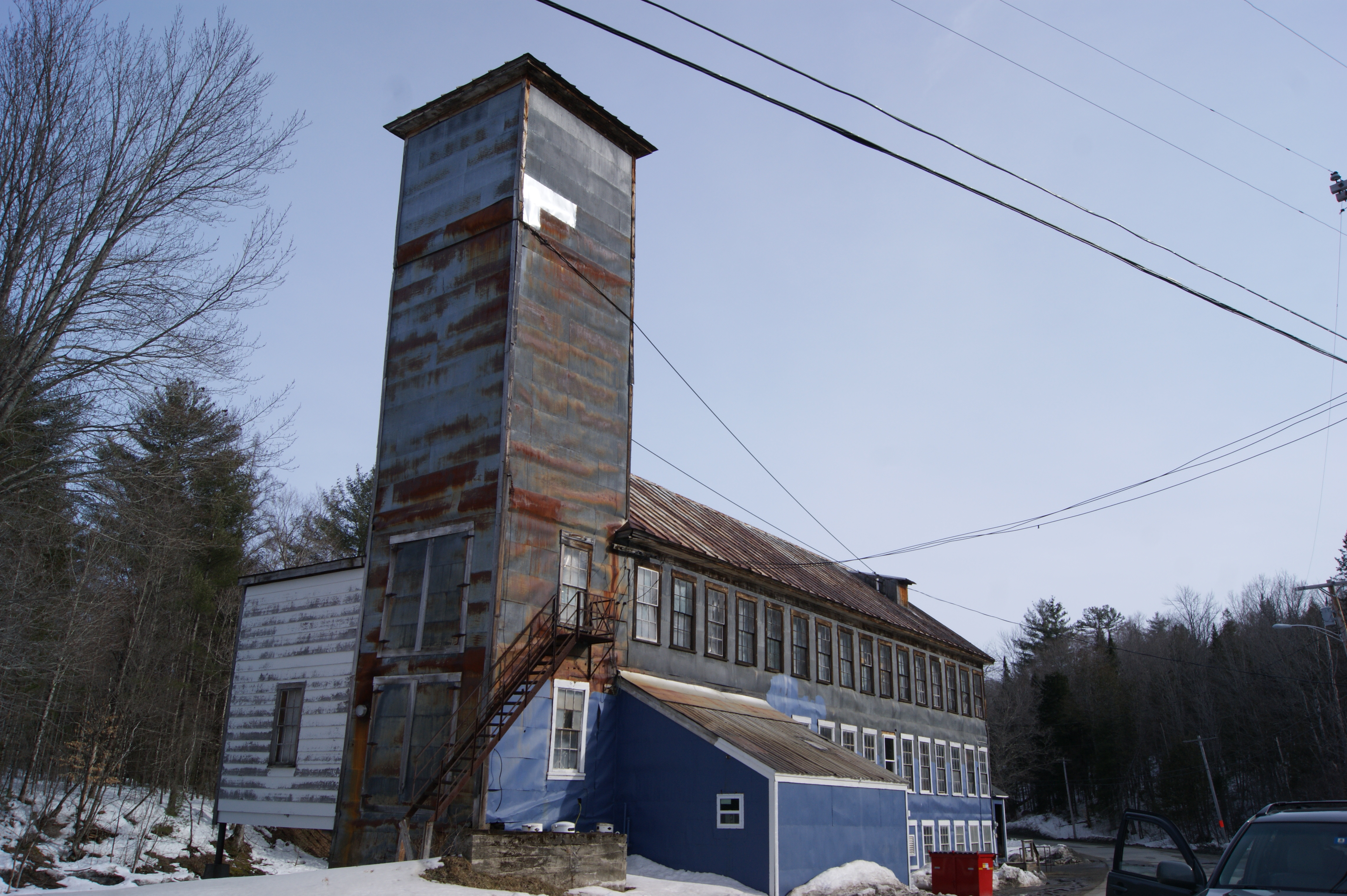
What do you think the viability is of creating a wool supply chain here in New England? What would need to happen in order to make this possible and how can farmers be best supported?
Educating farmers I think is probably the biggest hurdle that we have to overcome. The state of Maine does not produce enough fiber to keep us in business. We would generally need 50,000lbs of raw wool coming in each year and Maine doesn’t generate that much fiber, that’s why the area that we are bringing in fiber from is all of New England and parts of New York and Pennsylvania. We even get fiber in from Virginia and Maryland, so in order for the industry to expand, there is already plenty of capacity within the manufacturing side. We would need to have more growers producing more wool. The more people that are buying local, the more the mills are going to want to buy local and right now we are just in a catch 22 in that there’s not enough product in the area. I think it’s more about education, there is plenty of fiber out there but a lot of people don’t know what to do with it.”
What more do you think could be done to encourage people to truly value locally made wool products?
They have to learn that its got to be more than just the dollar, because too many people nowadays, well the first thing that they do is look at the price tag. That’s what happens a lot with clothing, and that has pushed a lot of the retailers to try and make their apparel lines as inexpensive as possible. If you go to where you buy your apparel and look at the label and see where it was made I guarantee 9 times out of 10 that it was made overseas in Jordan, Indonesia, Malaysia, Vietnam, not just China. Part of the pricing is because Maine has a mandatory $10/hr minimum wage, which boots everybody’s wages up… So if I’m paying people $15-$25/hr it just boosts the cost of manufacturing that product just that much more than somebody in China who is working for $2/day.
